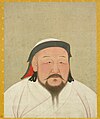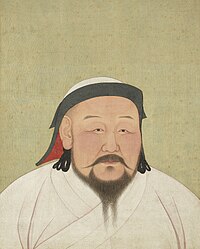Sary:YuanEmperorAlbumKhubilaiPortrait.jpg

Haben'ny topi-maso: 480 × 599 teboka. Habe hafa: 192 × 240 teboka | 385 × 480 teboka | 616 × 768 teboka | 821 × 1 024 teboka | 1 642 × 2 048 teboka | 3 221 × 4 018 teboka
Rakitra niaviana (3 221 × 4 018 teboka, haben'ilay rakitra : 13,02 Mio, endrika MIME : image/jpeg)
Tantara ny rakitra
Tsindrio eo amin'ny daty/ora iray mba hijery ny toetra n'ilay rakitra tamin'io fotoana io.
| Daty sy ora | saritapaka | Habe | Mpikambana | resaka | |
|---|---|---|---|---|---|
| ankehitriny | 21 Desambra 2022 à 11:19 |  | 3 221 × 4 018 (13,02 Mio) | Kcx36 | higher resolution |
| 24 Febroary 2021 à 12:46 |  | 2 678 × 3 200 (967 kio) | CAPTAIN MEDUSA | higher res | |
| 13 Oktobra 2016 à 00:03 |  | 1 339 × 1 600 (1,54 Mio) | Eugene a | True color | |
| 7 Desambra 2010 à 18:04 |  | 864 × 1 077 (123 kio) | Eugene a | Best version | |
| 25 Novambra 2010 à 18:21 |  | 480 × 618 (120 kio) | Dirrival | a better version | |
| 30 Septambra 2010 à 04:43 |  | 517 × 640 (68 kio) | Wmpearl | ||
| 28 Mey 2008 à 14:03 |  | 877 × 1 103 (161 kio) | Yaan | == Summary == {{Information |Description = Shizu, better known as Khubilai. Portrait cropped out of a page from an album depicting several Yuan emperors (Yuandai di banshenxiang), now located in the National Palace Museum in Taipei (inv. nr. zhonghua 0003 |
Fampiasana an'io rakitra io
Mampiasa ity rakitra ity io pejy io:
Fampiasan-drakitra maneran-tontolo
Mampiasa ity rakitra ity ireo wiki hafa ireo:
- Fampiasana eo amin'i af.wikipedia.org
- Fampiasana eo amin'i als.wikipedia.org
- Fampiasana eo amin'i ang.wikipedia.org
- Fampiasana eo amin'i an.wikipedia.org
- Fampiasana eo amin'i ar.wikipedia.org
- قوبلاي خان
- ويكيبيديا:في هذا اليوم/5 مايو
- إمبراطورية المغول
- بوابة:أعلام/صورة مختارة/أرشيف
- ويكيبيديا:صور مختارة/فنون/منمنمات
- بوابة:الإمبراطورية المغولية/شخصية مختارة
- بوابة:الإمبراطورية المغولية/شخصية مختارة/أرشيف
- بوابة:الإمبراطورية المغولية/شخصية مختارة/1
- ويكيبيديا:في هذا اليوم/مايو
- فن صيني
- ويكيبيديا:ترشيحات الصور المختارة/قوبلاي خان
- ويكيبيديا:صورة اليوم المختارة/مارس 2021
- قالب:صورة اليوم المختارة/2021-03-29
- بوابة:أعلام/صورة مختارة/42
- الحرب الأهلية التولوية
- ويكيبيديا:صورة اليوم المختارة/سبتمبر 2022
- قالب:صورة اليوم المختارة/2022-09-23
- Fampiasana eo amin'i ar.wikinews.org
- Fampiasana eo amin'i arz.wikipedia.org
- Fampiasana eo amin'i ast.wikipedia.org
- Fampiasana eo amin'i azb.wikipedia.org
- Fampiasana eo amin'i az.wikipedia.org
- Fampiasana eo amin'i ba.wikipedia.org
Hijery fampiasana eran-terikasan'ity rakitra ity.



